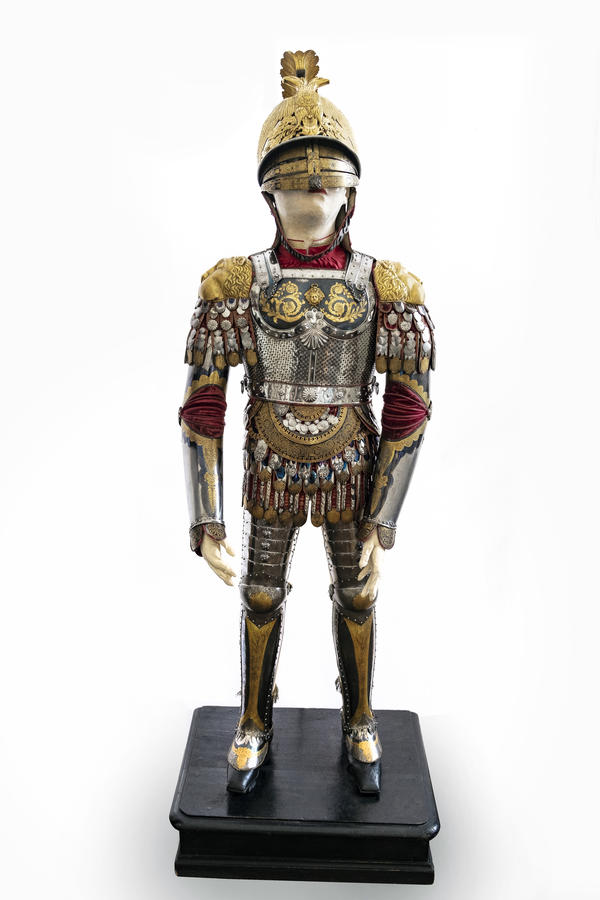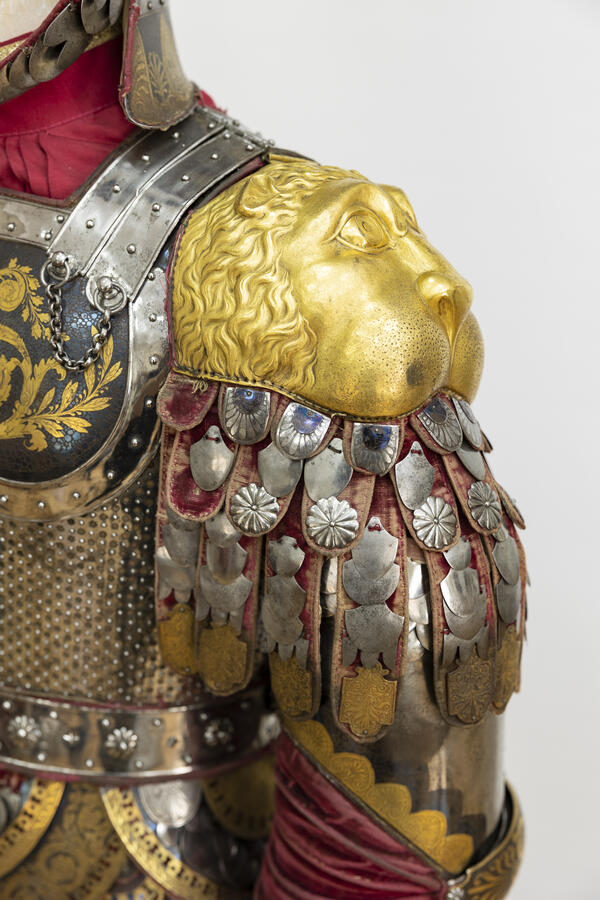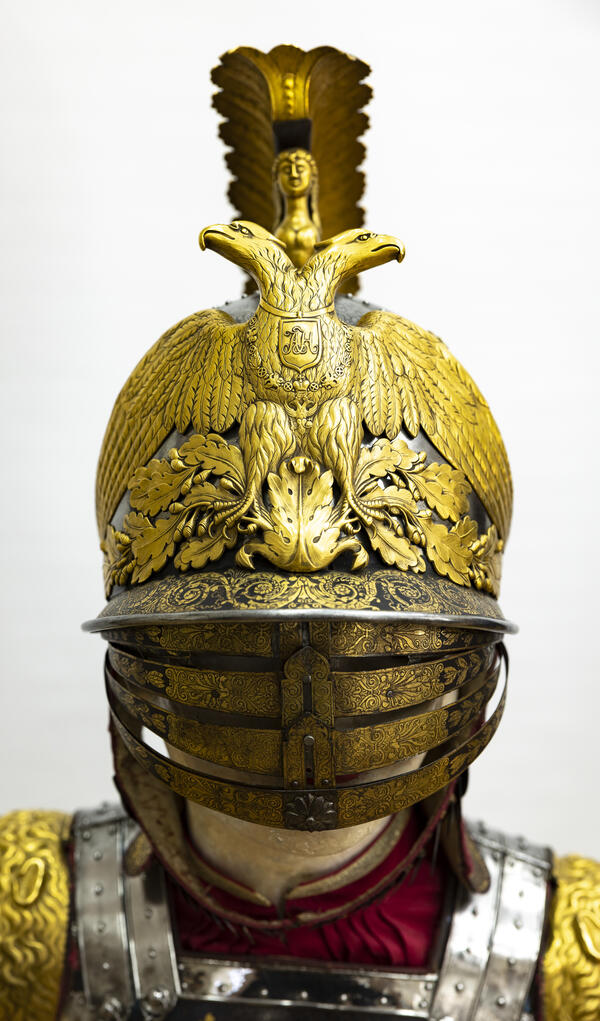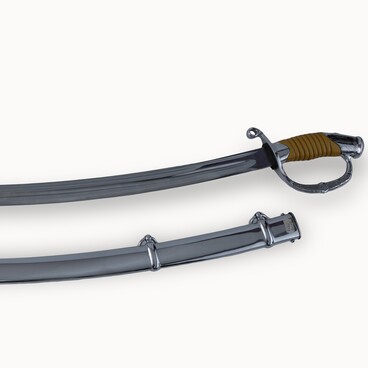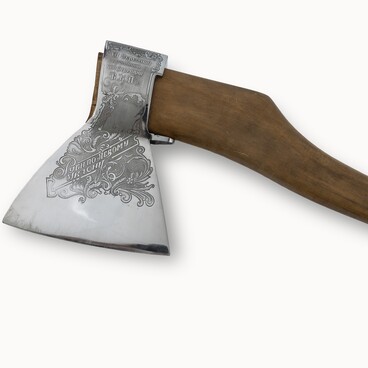The “Ancient Suit of Armor” was created in the first half of the 19th century. It was intended for the heir to the Russian throne, Tsarevich Alexander Nikolayevich. This suit is considered one of the most valuable and unique exhibits of the museum. In 2006, it received the status of an object of the scientific and technological heritage of Russia.
The “Ancient Suit of Armor” was made as a gift to the future Emperor Alexander II for his fifteenth birthday. Ivan Nikolayevich Bushuyev, master craftsman of the Zlatoust Arms Factory, not only came up with the design but also performed all the gilding work. Apart from him, about 30 craftsmen of the factory took part in the creation of the “Ancient Suit of Armor”.
The armor consisted of a cuirass, a helmet, handguards and greaves, a shield, a sword, and a spear. The “Ancient Suit of Armor” was decorated using all the techniques available at the factory at the time: etching, bluing, niello treatment, gilding, as well as cutting out (making through patterns), chasing, carving, and faceting.
The helmet features decorations in the form of a figure of a sphinx — a symbol of nobility, a double-headed eagle with laurel branches — a symbol of victory, and the winged stallion Pegasus. The shoulders bear lion heads, which meant strength and courage, and the chest plate features the head of Medusa (Gorgo). The middle of the shield bears an image of Minerva. Mars is depicted on one side of the sword blade, and Minerva (again) on the other.
The armor was ready as early as October 1833, but the gift was not sent to Saint Petersburg until the following year. Emperor Nicholas I was satisfied with the superb skills of the Zlatoust craftsmen. Nicholas I rewarded them with generosity that was truly royal: they were paid 3,000 rubles.
Unfortunately, the armor appeared before the tsar and his heir not as a complete set. Gone was the shield, which had been packed in the same box as the helmet, handguards and greaves, under a “false bottom”. In the house of the Minister of Finance, the boxes were opened, but no false bottom was found.
In 1928, the armor was returned to Zlatoust, but without the sword and the spear. The fate of the sword remains unknown; as for the spear, it was kept in the Hermitage funds under the name of a “hunting dart”. In fact, the exhibit is a memorial object of two historical figures: the founder of the art of Zlatoust steel engraving Ivan Bushuyev, and Emperor Alexander II the Liberator.
The “Ancient Suit of Armor” was made as a gift to the future Emperor Alexander II for his fifteenth birthday. Ivan Nikolayevich Bushuyev, master craftsman of the Zlatoust Arms Factory, not only came up with the design but also performed all the gilding work. Apart from him, about 30 craftsmen of the factory took part in the creation of the “Ancient Suit of Armor”.
The armor consisted of a cuirass, a helmet, handguards and greaves, a shield, a sword, and a spear. The “Ancient Suit of Armor” was decorated using all the techniques available at the factory at the time: etching, bluing, niello treatment, gilding, as well as cutting out (making through patterns), chasing, carving, and faceting.
The helmet features decorations in the form of a figure of a sphinx — a symbol of nobility, a double-headed eagle with laurel branches — a symbol of victory, and the winged stallion Pegasus. The shoulders bear lion heads, which meant strength and courage, and the chest plate features the head of Medusa (Gorgo). The middle of the shield bears an image of Minerva. Mars is depicted on one side of the sword blade, and Minerva (again) on the other.
The armor was ready as early as October 1833, but the gift was not sent to Saint Petersburg until the following year. Emperor Nicholas I was satisfied with the superb skills of the Zlatoust craftsmen. Nicholas I rewarded them with generosity that was truly royal: they were paid 3,000 rubles.
Unfortunately, the armor appeared before the tsar and his heir not as a complete set. Gone was the shield, which had been packed in the same box as the helmet, handguards and greaves, under a “false bottom”. In the house of the Minister of Finance, the boxes were opened, but no false bottom was found.
In 1928, the armor was returned to Zlatoust, but without the sword and the spear. The fate of the sword remains unknown; as for the spear, it was kept in the Hermitage funds under the name of a “hunting dart”. In fact, the exhibit is a memorial object of two historical figures: the founder of the art of Zlatoust steel engraving Ivan Bushuyev, and Emperor Alexander II the Liberator.

